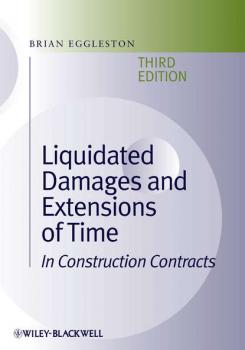ТОП просматриваемых книг сайта:
Brian Eggleston
Список книг автора Brian EgglestonАннотация
The ICE Conditions continues to be the dominant form of contract for civil engineering, despite the growing importance of the New Engineering Contract. The Seventh Edition of the ICE Conditions, published in 1999, introduced a number of changes, including: ? incorporating some of the concepts of the Latham Report ? amending certain provisions of the Sixth Edition which had attracted criticism ? rectifying conspicuous omissions from the text of earlier editions of the contract ? correcting small errors and faults from the previous edition ? modernising certain provisions and terms Brian Eggleston, whose previous book on the ICE Conditions was described as 'likely to become the authoritative reference source for the Sixth Edition', examines the contract clause by clause from a practical and legal viewpoint. There is extensive coverage of case law. Written by an experienced civil engineer and recognized authority on construction contracts, this book is an essential guide.
Аннотация
Liquidated damages and extensions of time are complex subjects, frequently forming the basis of contract claims made under the standard building and civil engineering contracts. Previous editions of Liquidated Damages and Extensions of Time are highly regarded as a guide for both construction industry professionals and lawyers to this complex area. The law on time and damages continues to develop with an increasing flow of judgments from the courts. Alongside this, the standard forms of contract have also developed over time to reflect prevailing approaches to contractual relationships. Against this background a third edition will be welcomed by construction professionals and lawyers alike. Retaining the overall approach of the previous editions, the author clarifies, in a highly readable but legally rigorous way, the many misunderstandings on time and damages which abound in the construction industry. The third edition takes account of a large volume of new case law since the previous edition was published over ten years ago, includes a new chapter on delay analysis and features significantly expanded chapters on penalty clauses, the effects of conditions precedent and time-bars, and the complexities of causation.
Аннотация
Now Available in Paperback From its launch in 1991 the New Engineering Contract has rapidly overtaken traditional building and civil engineering contracts to become the UK's leading standard form for major construction projects. Additionally, under the generic title NEC 3, there is now a family of New Engineering Contract standard forms. This book provides a detailed commentary on the latest edition of the main form – NEC 3 Engineering and Construction Contract. It explains how the contract is intended to operate and examines each clause to consider its application and legal interpretation. It draws upon the author's successful book on the second edition of the Engineering and Construction Contract, ECC 2, and it identifies and comments on the changes between ECC 2 and NEC 3. Particular attention is given to the revised compensation event procedures in NEC3, with five chapters of the book devoted to this subject. In-depth analysis is also given to: The role of the project manager The obligations of the parties The liabilities of the parties The revised dispute resolution procedures



